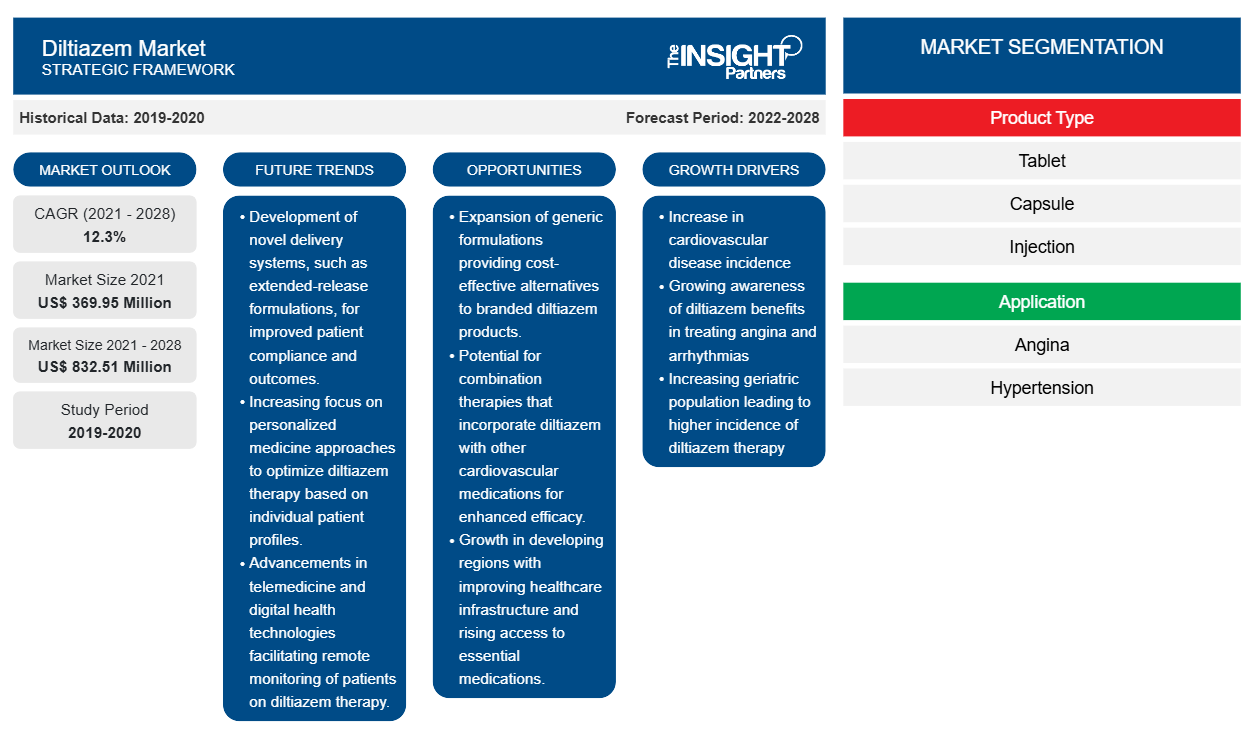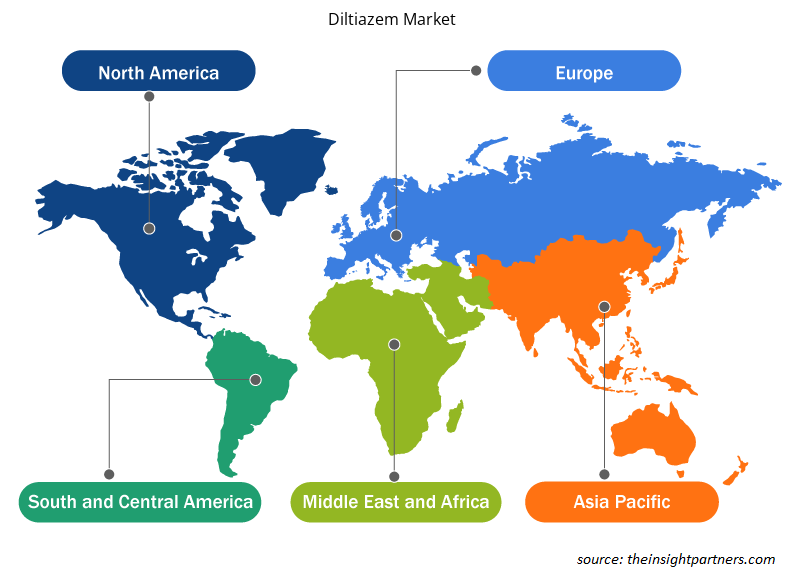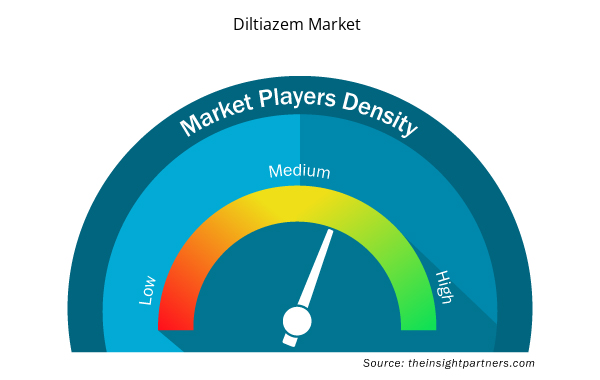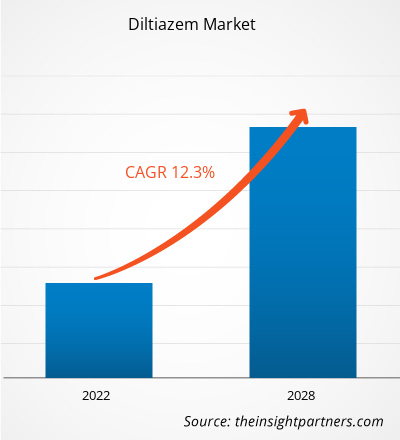The Diltiazem market is projected to reach US$ 832.52 million by 2028 from US$ 369.95 million in 2021; it is expected to grow at a CAGR of 12.3% from 2021 to 2028.
Factors such as increase in cardiovascular disease incidence and increasing elderly population are driving the market growth. However, side effects of diltiazem is likely to hamper the growth of the market.
Heart diseases are mostly observed in elderly people due to their weak immunity and major other health problems. The general aging factors lead to stiffening the heart and blood vessels that lead to heart disorders. As the age grows, the systolic blood pressure also rises, and it can cause cardiovascular disease. Thus, high blood pressure is a common cause of heart conditions in people aged 75 years and above. Coronary artery disease and heart failure are the next caused conditions. Although the incidence of arrhythmias is encompassing people of all age groups, its incidence is rising significantly among elderly people.
According to the Global Ageing 2019 survey, the world's population of people aged 65 and above totaled 703 million in 2019. The elderly demographic is expected to double to 1.5 billion people by 2050. The frequency of one person aged 65 and above is likely to increase from 1 in every 11 inhabitants in 2019 to 1 in every six inhabitants by 2025. This demographic is more susceptible to CVDs, such as arrhythmias. Similarly, according to the WHO, the percentage of people aged 60 years and above is estimated to reach 22% by 2050 from 12% in 2015. According to the report "Older Americans 2016: Key Indicators of Well-Being" by the Federal Interagency Forum on Aging-Related Statistics, 35.8% of individuals with age 85 and above had a mild or extreme cognitive disorder. Moreover, according to the United Nation's World Population Ageing 2017 report, in 2017, there were 962 million people across the world who were aged 60 years and above, and the number is expected to reach nearly 2.1 billion by 2050.
According to the US Census Bureau, the number of Americans aged 65 and above is expected to more than double from 46 million in 2016 to more than 98 million by 2060, with the 65-and-plus age group accounting for roughly 24% of the global population, up from 15% in 2016. In 2017, the European Union had the highest proportion of people aged 60 and above (25%). Other regions across the world are also experiencing a rising aging population, and by 2050, all regions of the world except Africa will have roughly a quarter or more of their inhabitants aged 60 and above. The number of elder people in the world is anticipated to reach US$ 1.4 billion by 2030 and US$ 2.1 billion by 2050 and will rise above US$ 3.1 billion by 2100. The elderly population is more prompt to have atypical presentations, comorbid conditions, and unfavorable outcomes. Structural and functional changes in the cardiovascular system associated with aging are major causes of cardiovascular diseases. Therefore, the rising geriatric population in the world leads to an increase in the incidence of cardiovascular disease, which bolsters the growth of the diltiazem market
Customize This Report To Suit Your Requirement
You will get customization on any report - free of charge - including parts of this report, or country-level analysis, Excel Data pack, as well as avail great offers and discounts for start-ups & universities
Diltiazem Market: Strategic Insights

- Get Top Key Market Trends of this report.This FREE sample will include data analysis, ranging from market trends to estimates and forecasts.
Customize This Report To Suit Your Requirement
You will get customization on any report - free of charge - including parts of this report, or country-level analysis, Excel Data pack, as well as avail great offers and discounts for start-ups & universities
Diltiazem Market: Strategic Insights

- Get Top Key Market Trends of this report.This FREE sample will include data analysis, ranging from market trends to estimates and forecasts.
Market Insights
Increase in Cardiovascular Disease Incidence
Diltiazem is a calcium channel blocker. It lowers the heart rate and works by relaxing blood vessels in the body and heart. Blood flows more easily, and the heart works less hard to pump blood. Diltiazem lowers myocardial oxygen demand through a reduction in heart rate, blood pressure, and cardiac contractility, also representing a good alternative for the treatment of stable chronic angina. Diltiazem has powerful cardiovascular effects caused by its actions on vascular smooth muscle, ventricular myocardium, and specialized conducting tissue. In individuals with normal ventricular function, it induces coronary and peripheral vasodilation, has a negative chronotropic and dromotropic impact, and has little to no negative inotropic effect. Diltiazem has potential use in a wide variety of cardiovascular disorders. It is extremely effective in relieving the coronary artery spasm associated with variant angina. When compared with nitrates in patients with exertional angina, diltiazem has similar efficacy.
According to the World Health Organization, cardiovascular diseases (CVDs) are the number one cause of death across the world. CVDs are a major cause of morbidity and affect more people than any other disease. A few CVDs are cerebrovascular disease, coronary heart disease, and rheumatic heart disease. Tobacco consumption, unhealthy diet, and physical inactivity are among major lifestyle factors that increase the risk of heart attacks and strokes. In addition, other risk factors that can lead to cardiovascular diseases are high blood pressure, diabetes, and increased cholesterol levels.
Atrial fibrillation (AFib) is the most common type of heart disorder, where the heart beats too fast, too slow, or in an irregular way. The Centers for Disease Control and Prevention (CDC) estimated that between 2.7 million and 6.1 million people are suffering from AFib in the US. In 2017, around 166,793 death certificates mention AFib and was the main cause deaths in 26,077 deaths. Every year over 454,000 hospitalizations and about 158,000 deaths are reported due to AFib in the US.
Furthermore, the European Society of Cardiology reported that Atrial fibrillation is the most common arrhythmia and accounts for 0.28% to 2.6% of healthcare spending in European countries. It also mentioned that patients suffering from atrial fibrillation have a five times higher risk of getting a stroke. From 20% to 30% of total strokes in Europe are caused due to atrial fibrillation. As per the study conducted by the European Society of Cardiology in 2016, ~7.6 million people aged 65 and more in the EU had atrial fibrillation. The European Society of Cardiology estimated that the number is expected to increase by 89% by 2060 and ~14.4 million people will have atrial fibrillation. Also, the prevalence of 7.8% is expected to reach 9.5% in 2060.
Furthermore, the prevalence of atrial fibrillation in Asia Pacific is also increasing. As per the report “BEYOND THE BURDEN: THE IMPACT OF ATRIAL FIBRILLATION IN ASIA PACIFIC” by Biosense Webster, published in 2019, more than 16 million people in Asia Pacific suffer from Atrial Fibrillation AF, which is affecting the middle-aged and the elderly population. The report also estimated that the number will reach about 72 million by 2050.
Prevalence of Atrial Fibrillation in APAC (by Country)
- This FREE sample will include data analysis, ranging from market trends to estimates and forecasts.
The calcium channel blockers diltiazem (Cardizem) and verapamil (Calan and Isoptin) are effective for initial ventricular rate control in patients with atrial fibrillation. These agents are given intravenously in bolus doses until the ventricular rate becomes slower. Furthermore, diltiazem reduces conduction in the atrioventricular node, which is also useful for heart rate control in patients with atrial fibrillation. Thus, the increasing prevalence of atrial fibrillation across the globe drives the growth of the diltiazem market.
Product Type-Based Insights
Based on product type, the market is segmented into capsules, injection, and tablets. In 2021, the tablets segment held the largest share of the market, whereas the capsules segment is expected to witness the fastest CAGR during 2021 to 2028.
Application -Based Insights
Based on application, the market is segmented into angina, hypertension, and others. In 2021, the hypertension segment held the largest share of the market, whereas the angina segment is expected to grow at the fastest CAGR during the coming years.
Companies operating in the diltiazem market emphasize on adopting the product innovations strategy to meet the evolving customer demands across the world, which also permits them to maintain their brand name in the global market.
Diltiazem Market Regional Insights
The regional trends and factors influencing the Diltiazem Market throughout the forecast period have been thoroughly explained by the analysts at Insight Partners. This section also discusses Diltiazem Market segments and geography across North America, Europe, Asia Pacific, Middle East and Africa, and South and Central America.

- Get the Regional Specific Data for Diltiazem Market
Diltiazem Market Report Scope
| Report Attribute | Details |
|---|---|
| Market size in 2021 | US$ 369.95 Million |
| Market Size by 2028 | US$ 832.51 Million |
| Global CAGR (2021 - 2028) | 12.3% |
| Historical Data | 2019-2020 |
| Forecast period | 2022-2028 |
| Segments Covered |
By Product Type
|
| Regions and Countries Covered | North America
|
| Market leaders and key company profiles |
Diltiazem Market Players Density: Understanding Its Impact on Business Dynamics
The Diltiazem Market market is growing rapidly, driven by increasing end-user demand due to factors such as evolving consumer preferences, technological advancements, and greater awareness of the product's benefits. As demand rises, businesses are expanding their offerings, innovating to meet consumer needs, and capitalizing on emerging trends, which further fuels market growth.
Market players density refers to the distribution of firms or companies operating within a particular market or industry. It indicates how many competitors (market players) are present in a given market space relative to its size or total market value.
Major Companies operating in the Diltiazem Market are:
- Bausch Health
- Teva Pharmaceutical Industries Ltd
- Mylan N.V
- Athenex
- Pfizer, Inc
Disclaimer: The companies listed above are not ranked in any particular order.

- Get the Diltiazem Market top key players overview
Diltiazem Market – Segmentation
By Product Type
- Tablet
- Capsules
- Injection
By Application
- Hypertension
- Angina
- Others
Diltiazem Market– by Geography
- North America
- US
- Canada
- Mexico
- Europe
- France
- Germany
- Italy
- UK
- Spain
- Rest of Europe
- Asia Pacific (APAC)
- China
- India
- South Korea
- Japan
- Australia
- Rest of APAC
- Middle East and Africa (MEA)
- South Africa
- Saudi Arabia
- UAE
- Rest of MEA
- South and Central America (SCAM)
- Brazil
- Argentina
- Rest of SCAM
Company Profiles
- Bausch Health
- Teva Pharmaceutical Industries Ltd
- Mylan N.V
- Athenex
- Pfizer, Inc,
- Glenmark
- Sandoz (Novartis Ag)
- Sun Pharmaceutical Company Ltd
- Hikma Pharmaceuticals
- Zydus Pharmaceuticals
- Historical Analysis (2 Years), Base Year, Forecast (7 Years) with CAGR
- PEST and SWOT Analysis
- Market Size Value / Volume - Global, Regional, Country
- Industry and Competitive Landscape
- Excel Dataset


- Visualization and 3D Rendering Software Market
- Constipation Treatment Market
- Battery Testing Equipment Market
- Maritime Analytics Market
- Analog-to-Digital Converter Market
- Cut Flowers Market
- Small Molecule Drug Discovery Market
- Diaper Packaging Machine Market
- Hydrogen Storage Alloys Market
- Pressure Vessel Composite Materials Market

Report Coverage
Revenue forecast, Company Analysis, Industry landscape, Growth factors, and Trends

Segment Covered
Product Type ; Application

Regional Scope
North America, Europe, Asia Pacific, Middle East & Africa, South & Central America

Country Scope
Argentina, Australia, Brazil, Canada, China, France, Germany, India, Italy, Japan, Mexico, RoAPAC, RoE, RoMEA, RoSCAM, Saudi Arabia, South Africa, South Korea, Spain, United Arab Emirates, United Kingdom, United States
Frequently Asked Questions
Asia Pacific is expected to be the fastest-growing region and is likely to expand at a high growth rate due to government initiatives in drug approval process. Moreover, the rise in prevalence of cardiovascular disease such as angina, hypertension and arrythmia is likely to boost the growth of market in Asia-Pacific region. For instance, The rise in the cardiovascular diseases is observed due to the rise in the risk factors such as smoking, blood pressure, cholesterol and diabetes. The percentage of men who smoke in Japan is approximately 35.4% which is nearly double than the rate of smoking in US. The average blood pressure in Japan is nearly 130.5 and the cholesterol leverage averages approximately 201 mg/dl (5.2 mmol/L). However, the rate of diabetes is little less, compared to the rate in US. The rate of diabetes in Japan is approximately 7.2%. Owing to these factors the country is likely to demand more of the cardiovascular diagnostic and treatment devices in future.
The global diltiazem market based on product is segmented into capsules, injection, and tablets. In 2021, the tablets segment held the largest share of the market, by product type. However , the capsules segment of Diltiazem Market is also expected to witness fastest CAGR of 12.8% during 2021 to 2028. Factors such as increase in cardiovascular disease incidence and increasing elderly population are driving the market growth. However, side effects of diltiazem is likely to hamper the growth of the market.
The Diltiazem market majorly consists of the players such as Bausch Health, Teva Pharmaceutical Industries Ltd, Mylan N.V, Athenex, Pfizer, Inc, Glenmark, Sandoz (Novartis Ag),Sun Pharmaceutical Company Ltd, Hikma Pharmaceuticals, Zydus Pharmaceuticals among others amongst others.
The US is the largest market for Diltiazem at a global level., In the United States hypertension was a primary or contributing factor in roughly half a million deaths in in recent years. Hypertension-related deaths have increased by 72 percent and 20 percent in rural and urban areas of the United States, respectively. According to Centers for Disease Control and Prevention, high blood pressure costs the United States about $131 billion each year. In the United States, heart disease is the leading cause of death for men, women, and people of most racial and ethnic groups. According to the WHO in the United States, one person dies from cardiovascular disease every 36 seconds. Every year, over 655,000 Americans die from heart disease, accounting for one out of every four deaths.
Diltiazem is a benzothiazepine derivative that acts as an antihypertensive and vasodilator. Diltiazem is an antihypertensive and vasodilator that lowers blood pressure by relaxing the vascular muscle. This is due to the long-term therapeutic effects of decreasing blood pressure since it lowers the risk of fatal and non-fatal cardiovascular events, such as strokes and myocardial infarction. According to in vitro binding experiments, diltiazem is 70%-80% bound to plasma proteins. 12 At clinically relevant concentrations, around 40% of the medication is thought to attach to alpha-1-glycoprotein, whereas about 30% of the drug is thought to bind to albumin.
The factors that are driving and restraining factors that will affect Diltiazem market in the coming years. Factors such as increase in cardiovascular disease incidence and increasing elderly population are driving the market growth. However, side effects of diltiazem is likely to hamper the growth of the market.
Trends and growth analysis reports related to Life Sciences : READ MORE..
The List of Companies - Diltiazem Market
- Bausch Health
- Teva Pharmaceutical Industries Ltd
- Mylan N.V
- Athenex
- Pfizer, Inc
- Glenmark
- Sandoz (Novartis Ag)
- Sun Pharmaceutical Company Ltd
- Hikma Pharmaceuticals
- Zydus Pharmaceuticals

 Get Free Sample For
Get Free Sample For